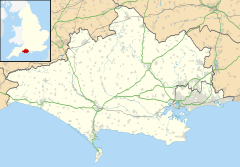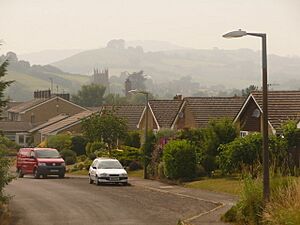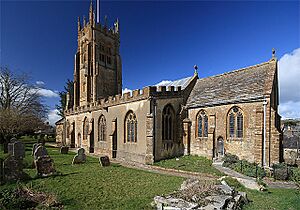Beaminster facts for kids
Quick facts for kids Beaminster |
|
|---|---|
 Beaminster town centre |
|
| Population | 3,177 2021 census |
| OS grid reference | ST4701 |
| • London | 145 miles (233 km) |
| Civil parish |
|
| Unitary authority |
|
| Ceremonial county | |
| Region | |
| Country | England |
| Sovereign state | United Kingdom |
| Post town | Beaminster |
| Postcode district | DT8 |
| Dialling code | 01308 |
| Police | Dorset |
| Fire | Dorset |
| Ambulance | South Western |
| EU Parliament | South West England |
| UK Parliament |
|
| Website | Beaminster Town Council |
Beaminster (/ˈbɛmɪnstər/ BEM-in-stər) is a charming town and civil parish in Dorset, England. It's located about 15 miles (24 km) northwest of Dorchester, the county town. Beaminster sits in a valley shaped like a bowl, close to where the small River Brit begins. In the 2021 census, about 3,177 people lived in Beaminster parish.
The town has a long history, going back to the Anglo-Saxon age around the 7th century. It was once called Bebingmynster, which means "the church of Bebbe." This suggests it was an important church site and the center of a large estate.
For many years, Beaminster was known for making linen and woollen fabrics. The materials came from the sheep and flax grown in the nearby countryside. The town faced tough times, with three big fires in the 17th and 18th centuries. One fire, during the English Civil War, almost completely destroyed the town.
Beaminster's main church, the Church of St Mary, is famous for its beautiful design, especially its tall tower. It's considered a very important historic building.
Contents
History of Beaminster
Early Beginnings and Domesday Book
Beaminster has roots stretching back to Anglo-Saxon times. The name "Bebingmynster" suggests it was an important church center. In 1086, the town was mentioned in the Domesday Book. This was a huge survey ordered by William the Conqueror. It showed that the land of Beaminster was owned by the See of Salisbury.
Fires and Civil War
During the English Civil War in the 1640s, Beaminster supported Parliament. Because of this, Royalist soldiers attacked the town in 1644. A fire started when a musket was accidentally fired into a thatched roof. This fire almost completely burned down the town. Beaminster also had two more accidental fires in 1684 and 1781.
Industry and Decline
In the past, Beaminster was a busy place for making linen and wool. Farmers grew flax and raised sheep on the surrounding hills. The town was once more important than it is today. Many factories were built in the 18th and early 19th centuries. There were even as many as seventeen inns in the town in the early 1900s!
However, Beaminster didn't get a railway line. This meant other towns like Bridport and Dorchester grew more quickly. Beaminster became less central as a result.
Horn Park House
About 1.5 miles (2.5 kilometres) northwest of Beaminster is Horn Park. It's a large country house built in 1911. The house has a special design, with interesting arched ceilings inside. Its gardens are sometimes open to visitors.
Geography of Beaminster
Beaminster is located in a valley that looks like a bowl. It sits about 50 to 80 metres (160–260 ft) above sea level. All around the town are hills, with Beaminster Down to the northeast rising to 244 metres (801 ft).
The River Brit and many small streams start from springs on the hills above Beaminster. Several of these streams meet within the town. Because of this, Beaminster has grown in a shape that looks a bit like a star, following the paths of these streams.
Beaminster is about 45 miles (72 km) south of Bristol and 15 miles (24 km) northwest of Dorchester.
Local Geology
Beaminster is mainly built on a type of clay called fuller's earth. The hills around the town are made of different kinds of rock, including chalk and sand. There are also several natural cracks in the earth, called faults, running through the area.
Population of Beaminster
In 2013, the population of Beaminster parish was estimated to be 3,100 people. The population has grown over the years. In 1921, there were 1,651 people, and by 2001, it had reached 2,920. The 2011 census counted 3,136 people living in Beaminster and the small nearby parish of Mapperton.
Economy and Community Life
Beaminster is home to some interesting businesses. A factory in the town, now part of International Flavors & Fragrances, makes Nisaplin. This is a natural ingredient used to keep food fresh. It was first discovered and produced here in the 1950s.
The Clipper Teas company, known for its organic and fair trade teas, is also based in Beaminster. It is owned by a Dutch company called Royal Wessanen.
Beaminster is a lively place with events and activities.
- The Beaminster Festival is an annual event that celebrates music and art.
- The Whitcombe Disc golf course in Beaminster has hosted big championships, including the British Open and the European Disc Golf Championship in 2003.
- The town is twinned with Saint-James in France, meaning they have a special friendship connection.
- Buckham Fair was a popular event held annually near the town for ten years. It was a vintage fair that raised money for charity.
Transport in Beaminster
The closest train station to Beaminster is Crewkerne, about 5 miles (8 km) north of the town. If you want to fly, Exeter International Airport is about 30 miles (48 km) to the west.
The main road through Beaminster is the A3066. This road goes south to Bridport and north to Mosterton and Crewkerne. The road heading north goes through the Horn Hill tunnel. This tunnel opened in 1832 and is one of the oldest road tunnels still used every day!
Media and News
For local news and TV shows, Beaminster gets its signals from BBC South West and ITV West Country.
You can listen to local radio stations like BBC Radio Solent (103.8 FM), Heart West (97.1 FM), Greatest Hits Radio Dorset (97.2 FM), and Abbey104 (107.4 FM), which is a community radio station. The local newspaper for the town is the Dorset Echo.
Local Government
Beaminster has two levels of local government. The first is the Beaminster Town Council, which looks after local town matters. They meet at the Public Hall on Fleet Street. The second is Dorset Council, which is a larger authority covering the whole area.
For national elections, Beaminster is part of the West Dorset constituency. This means people in Beaminster vote for a Member of Parliament to represent them in the Parliament of the United Kingdom.
Education in Beaminster
Beaminster has several schools for young people.
- Primary Schools: St Mary's Church of England Primary School is one of the primary schools in the town.
- Secondary Schools: Beaminster School is the town's secondary school. It also has a combined sixth form with The Sir John Colfox Academy in nearby Bridport.
- Special Schools: Mountjoy School, which helps students with special educational needs, shares a site with Beaminster School.
- Higher Education: Hooke Park is a special campus for the Architectural Association School of Architecture. It's located in a woodland area.
Religion in Beaminster
Beaminster has two main churches: an Anglican church called St Mary of the Annunciation, and a Catholic church called St John's.
St Mary's Church is especially famous for its beautiful design. Its tower is often called "the glory of Beaminster" because it's so impressive. Most of the church was built in the 15th and 16th centuries. However, some parts, like the font bowl, are even older, from the late 12th century.
Beaminster in Books
Beaminster has appeared in famous books!
- Author Thomas Hardy called it "Emminster" in his well-known novel Tess of the d'Urbervilles.
- The Dorset poet William Barnes wrote a poem about Beaminster, describing its "green and woody hills."
- It's also a setting for part of the science fiction novel The Day of the Triffids by John Wyndham.
Famous People from Beaminster
Many interesting people have connections to Beaminster:
- Samuel Hearne: This Arctic explorer and naturalist spent his childhood in Beaminster. Some people think he inspired the character in Samuel Taylor Coleridge's famous poem, The Rime of the Ancient Mariner.
- Martin Clunes: The well-known actor, famous for shows like Doc Martin, lives in Beaminster.
- Lynne Reid Banks: This author, who wrote The L-Shaped Room and The Indian in the Cupboard, also lived in the town. Both of her books were made into films.
- John Makepeace: A famous furniture maker, he now lives in Beaminster. He used to run a school for craftsmen in wood at nearby Parnham House.
- William Barnard Rhodes-Moorhouse: He was the first airman ever to receive the Victoria Cross, a very brave award. He lived at Parnham House.
Twin Town
Beaminster has a special friendship with another town:
- Saint-James, Normandy, France
See also
 In Spanish: Beaminster para niños
In Spanish: Beaminster para niños






